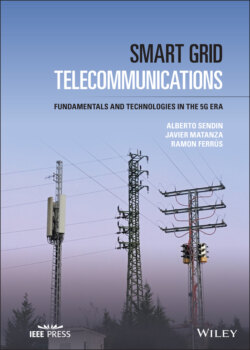Читать книгу Smart Grid Telecommunications - Ramon Ferrús - Страница 45
1.6.6 Environmental Conditions
ОглавлениеThe harsh conditions of most grid sites are one of the most important aspect that need to be taken into account when designing a telecommunications network for Smart Grids or when using telecommunications services provided by a TSP. It needs to be born in mind that most electric grid premises are neither set up in the way a telecommunications site would be, nor service points are typical residential houses.
On the contrary, there are many aspects that need to be considered to design telecommunication products for Smart Grids. We will refer to them as non‐functional requirement (“functional” refers to their function within the telecommunications network), and they include electrical, Electromagnetic Compatibility (EMC), and environmental requirements. Most of them prevent a cost‐effective introduction of telecommunication elements in the Smart Grid.
IEC and IEEE are the two main bodies that tackle the specific requirements for devices to be installed at substations and similar locations.
IEC has several series of standards setting requirements as a reference for Smart Grid‐related equipment in substations. Technical Committee TC 57 “Power Systems Management and Associated Information Exchange,” dealing with “power systems control equipment and systems including EMS (Energy Management Systems), SCADA (Supervisory Control And Data Acquisition), distribution automation, teleprotection, and associated information exchange for real‐time and non‐real‐time information, used in the planning, operation and maintenance of power systems,” is the most relevant in this context, while TC 95 “Measuring relays and protection equipment” has a certain role for some device types in the grid (their non‐functional requirements might also be considered to the extent where there is not a better reference):
IEC 60870 “Telecontrol Equipment and Systems”, within TC57. This series has a broad scope in terms of monitoring and control, not just in the substation:IEC 60870‐2‐1 focuses on electromagnetic compatibility.IEC 60870‐2‐2 focuses on environmental conditions (climatic, mechanical, and other nonelectrical influences) and partially supersedes IEC 60870‐2‐1.
IEC 61850 “Communication Networks and Systems for Power Utility Automation,” also within TC 57, is much more recent than the IEC 60870 series and focuses in substations and power plants:IEC 61850‐3 focuses on environmental aspects of utility communication and automation IEDs and systems.
IEC 60255 “Measuring relays and protection equipment” and “Electrical Relays” in TC 95 gives requirements specifically for protection devices.
In IEEE, the Power and Energy Society's Substations Committee produced IEEE 1613 to specify “standard service conditions, standard ratings, environmental performance requirements and testing requirements for communications networking devices installed in electric power substations.” It complements IEC 61850‐3. This standard has broadened its scope with IEEE 1613.1 (in collaboration with the Transmission and Distribution Committee), to cover other devices installed in all electric power facilities, not just substations, specifically applicable for devices used in DA and DG. Interestingly, it explicitly mentions device testing and performance requirements for communications via Radio Frequency (RF), Power Line Communications (PLC), Broadband over Power Line (BPL), or Ethernet cable.
In terms of electrical requirements, devices that are to be part of a Smart Grid deployment usually have to respect specific constraints in terms of voltage and frequency levels (admitted tolerances), power supply redundancy, battery lifetime, etc. These constraints are normally specific to the type of equipment and its location. IEC and IEEE differ in the way they fix some of these values.
A group of very relevant requirements refers to EMC. EMC collates different groups of aspects: radiated and conducted emissions, immunity to radiated and conducted disturbances, insulation, electrostatic discharge immunity, electrical fast transient/burst immunity, surge immunity, voltage‐dips/interruption immunity, etc. For conducted or radiated emission limits CISPR 32 is usually considered. Immunity requirements may be taken from tests proposed in IEC 61000‐4 series.
The rest of non‐functional requirements fall in the environmental category. This group refers to climatic and mechanical (vibration, shock, seismic) conditions, to be taken into account in the product lifecycle (storage, transportation, and in normal‐use regime) according to their different environmental conditions (weather‐protected, temperature control; stationary use, mobile use, portable use, etc.). There is a very complete reference in Europe in ETSI 300 019 series. The tests for the different classes are based on IEC 60068‐2 series “Environmental Testing – Part 2: Tests.” Alternatively, a much simpler reference is IEEE 1613.1. IK codes (IEC 62262) and IP codes (IEC 60529) for protection against ingress of solid foreign objects and against ingress of water with harmful effects need also to be taken into consideration, although these are not very different from other fields. Recommended limits for all these aspects can be found in [34].
There is a very important aspect that influences the relationship between telecommunications and the substation environment, and it has to do with earthing/grounding aspects [61]. Substations protect all elements inside them from unexpected HV events such as power faults and lightning strikes (anything that may cause a discharge of large amounts of electrical energy into its surroundings) by providing an equal‐potential zone with its ground grid. The substation ground grid connects all metal parts together to create an equipotential zone, so that everything within the compound is at the same potential. While this creates a safety mechanism for the substation, it will affect any externally connected metallic cable, if it is not properly engineered. This situation has been widely studied for PSs in IEEE 367‐2012, IEEE 487‐2015, and IEEE 1590‐2009, and although HV insulators have been developed to allow for the safe connection of, e.g., copper pairs reaching the substation from TSPs premises, the installation of optical fiber in dielectric cables, or radio‐based solutions, is preferred to connect substations. The situation is similar in SSs; although distances within SSs are much smaller, the MV ground reference is different to the LV ground reference of the neutral wire, and this imposes extra insulation requirements in devices connected to the MV and LV ground references, simultaneously.
